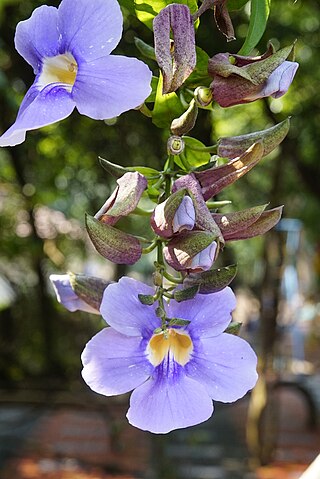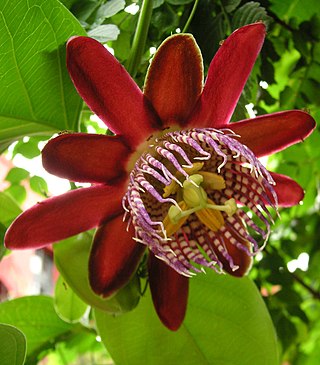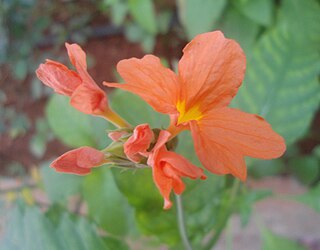
Petunia is a genus of 20 species of flowering plants of South American origin. The popular flower of the same name derived its epithet from the French, which took the word pétun, 'tobacco', from a Tupi–Guarani language. A tender perennial, most of the varieties seen in gardens are hybrids.

Rudbeckia hirta, commonly called black-eyed Susan, is a North American flowering plant in the family Asteraceae, native to Eastern and Central North America and naturalized in the Western part of the continent as well as in China. It has now been found in all 10 Canadian Provinces and all 48 of the states in the contiguous United States.

Fremontodendron, with the common names fremontia and flannelbush or flannel bush, is a genus of three known species of shrubs native to the Southwestern United States and northwest Mexico.

Thunbergia is a genus of flowering plants in the family Acanthaceae, native to tropical regions of Africa, Madagascar and southern Asia. Thunbergia species are vigorous annual or perennial vines and shrubs growing to 2–8 m tall. The generic name honours the Swedish naturalist Carl Peter Thunberg (1743-1828).
Black-eyed Susan may refer to:

Caesalpinia pulcherrima is a species of flowering plant in the pea family Fabaceae, native to the tropics and subtropics of the Americas. It could be native to the West Indies, but its exact origin is unknown due to widespread cultivation. Common names for this species include poinciana, peacock flower, red bird of paradise, Mexican bird of paradise, dwarf poinciana, pride of Barbados, flos pavonis, and flamboyant-de-jardin. The Hawaiian name for this plant is ʻohai aliʻi.

Papaver nudicaule, the Iceland poppy, is a boreal flowering plant. Native to subpolar regions of Asia and North America, and the mountains of Central Asia as well as temperate China, Iceland poppies are hardy but short-lived perennials, often grown as biennials. They yield large, papery, bowl-shaped, lightly fragrant flowers supported by hairy, 1 foot (30 cm) curved stems among feathery blue-green foliage 1-6 inches long. They were first described by botanists in 1759. The wild species blooms in white or yellow, and is hardy from USDA Zones 3a-10b.

Thunbergia mysorensis, the Mysore trumpetvine or lady's slipper vine, is a species of flowering plant in the family Acanthaceae. A woody-stemmed evergreen, this vine is native to southern tropical India. The specific epithet mysorensis is derived from the city of Mysore.

Thunbergia alata, commonly called black-eyed Susan vine, is a herbaceous perennial climbing plant species in the family Acanthaceae. It is native to Eastern Africa, and has been naturalized in other parts of the world.

Thunbergia laurifolia, the laurel clockvine or blue trumpet vine, is native to India and Thailand and the Indomalayan realm, the species occurs from Indochina to Malaysia.

Passiflora alata, the winged-stem passion flower, is a species of flowering plant. It is an evergreen vine, growing to 6 m (20 ft) or more, which bears an edible type of passion fruit. It is native to the Amazon, from Peru to eastern Brazil.

Gazania rigens, sometimes called treasure flower, is a species of flowering plant in the family Asteraceae, native to coastal areas of southern Africa. It is naturalised elsewhere and is widely cultivated as an ornamental plant.

Crossandra infundibuliformis, the firecracker flower, is a species of flowering plant in the family Acanthaceae, native to southern India and Sri Lanka. It is most often found in south Indian region Andhra Pradesh, tamilnadu,and kerala.

Pandorea pandorana, commonly known as the wonga wonga vine or wonga-vine, is a species of flowering plant in the family Bignoniaceae and is native to Australia, Malesia and the southwestern Pacific region. It is a woody scrambler or climber with pinnate leaves, juvenile leaves differing from those of mature plants. The flowers are tubular or funnel-shaped and white with purple markings and the fruit are capsules containing winged seeds. It is easy species to germinate and is a popular garden plant. Common cultivars include the yellow-flowered P. 'Golden Showers', the white-flowered P. 'Snowbells', and the pinkish P. 'Ruby Belle'. The wood was used in making spears for woomeras in the Central and Western deserts.

Thunbergia erecta (Benth.) T. Anders., commonly known as the bush clock vine or king's mantle, is a vibrant, evergreen shrub that belongs to the family Acanthaceae. Native to the forest zone stretching from Guinea-Bissau to Western Cameroon, it has found significant cultivation worldwide due to its ornamental appeal and versatility. The plant is particularly known for its erect or scandent growth habit, reaching a notable height of up to five meters or more. This robust shrub displays a fascinating range of pale to dark violet-purple flowers that contribute to its visual appeal and broad popularity. Each flower measures between 5.0 to 7.5 cm in length, hosting a stark white tube at their core. This striking color contrast lends an undeniable charm to the plant, making it a favored choice in various garden settings and landscapes.

Thunbergia grandiflora is an evergreen vine in the family Acanthaceae. It is native to China, India, Nepal, Bangladesh, Indochina and Myanmar and widely naturalised elsewhere. Common names include Bengal clockvine, Bengal trumpet, blue skyflower, blue thunbergia, blue trumpetvine, clockvine, skyflower and skyvine.

Gynura aurantiaca, called purple passion or velvet plant, is a species of flowering plant in the daisy family Asteraceae. It is native to Southeast Asia but grown in many other places as a house plant. In warm regions, it is frequently grown outdoors on patios and in gardens rather than inside buildings, and hence it has escaped into the wild in Africa, Australia, South America, Mesoamerica, Florida, and a few other places.

Thunbergia atriplicifolia, the Natal primrose, is a species of flowering plant in the family Acanthaceae, native to South Africa and Eswatini. It is a favored browse of the steenbok.

Thunbergia battiscombei, also known as the blue glory vine, is a species of flowering plant within the family Acanthaceae. It is sometimes used as an ornamental garden plant for its beautiful large blooms and leafy foliage. Thunbergia battiscombei is also cultivated as a herb within its native range. Some people superstitiously believe the herb is able to help remedy mental imbalance, curses and black magic.

In gardening, the term free-flowering is used to describe flowering plants that have a long bloom time and may often lack a defined blooming season, whereby producing flowers profusely over an extended period of time, at times all-year round. The terms long-flowering and long-blooming are also used for perennial plants that bloom for much of the year.




















